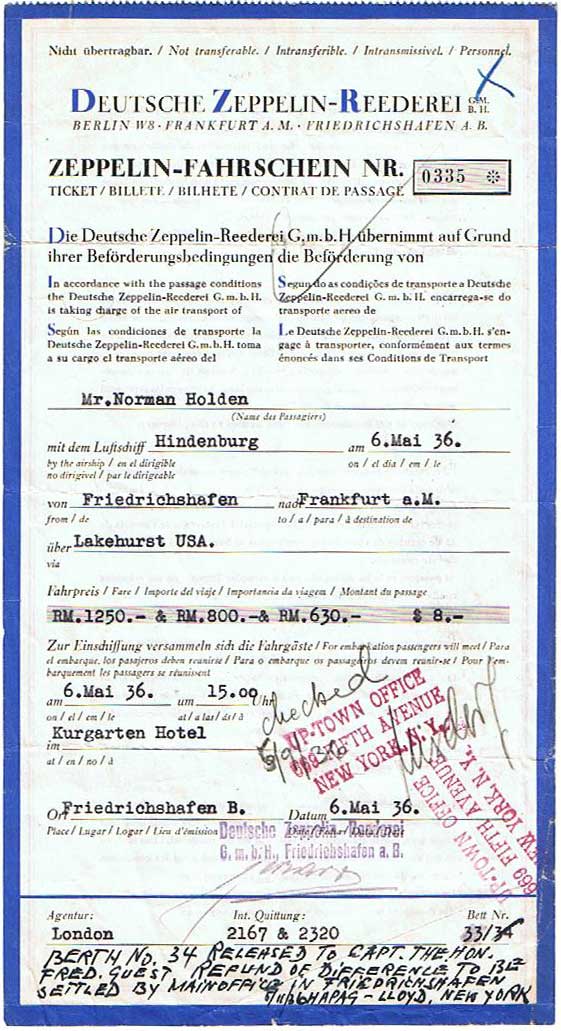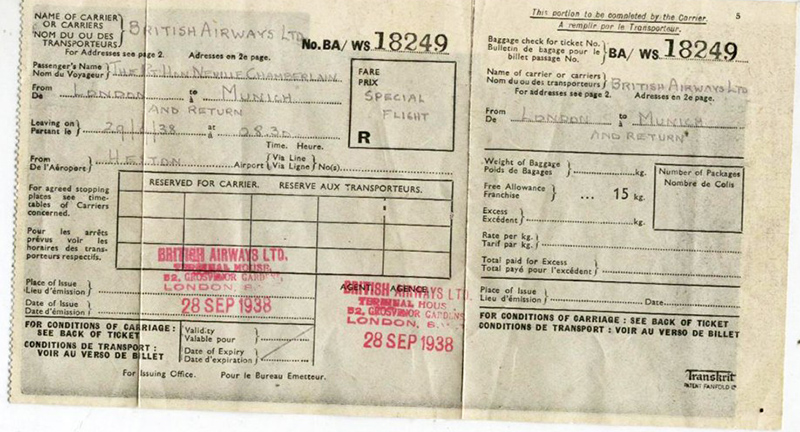|
|
 
|
|
Author
|
Topic: weird airline question (how does this happen?)
|
|
|
|
|
|
|
|
|
|
|
|
|
Scott Norwood
Film God

Posts: 8146
From: Boston, MA. USA (1774.21 miles northeast of Dallas)
Registered: Jun 99
|
 posted 07-23-2015 06:42 AM
posted 07-23-2015 06:42 AM





I always assumed that the time listed on the schedule board was the time when one could no longer board the plane. In this case, the flight was listed as "11:50" (originally), which implies to me that a passenger who showed up at the gate at 11:49 with a valid boarding pass would be allowed to board. Is this not the case? (obviously, in the case of the "rescheduled" flight time, a passenger who showed up at 11:49 would be screwed). Similarly, I assumed that the arrival times listed in schedules would be the time when passengers would be allowed to exit the plane, and that the actually takeoff/landing times were of concern only to the pilots and ATC personnel. Yes? No?
Related question: why do/did airlines separate the "ticket" part of a ticket from a "boarding pass"? At least historically, passengers would buy a ticket for their flight and then use it at check-in to obtain a boarding pass with a seat assignment. Now, the "ticket" part is usually just a database record, but the same concept applies. Anywhere else (movie theatre, train, sporting event, etc.), the "ticket" is all that is necessary to gain admission to the venue and contains the seating assignment (if applicable). Why do airlines feel the need to make this simple process more complicated?
| IP: Logged
|
|
Leo Enticknap
Film God

Posts: 7474
From: Loma Linda, CA
Registered: Jul 2000
|
 posted 07-23-2015 10:49 AM
posted 07-23-2015 10:49 AM







If these examples are in any way typical (which, clearly, the latter is not, though it appears to be on their standard stationery form), it would seem that different airlines did different things in the 1930s. The Zeppelin ticket has the berth number on it, so presumably that's all you needed to go through the terminal and onto the airship. But the BA ticket has no seating information, and so unless seats were completely unassigned in those days, presumably you were given another document with your seat number on it.
We know that Chamberlain didn't need any excess baggage allowance, unless his briefcase and that infamous piece of paper exceeded 15kg (though if Ryanair had been around in those days, he'd have probably had to pay a supplement for them)!
Given the weight restrictions on planes in those days, I'm surprised that you were allowed an inclusive 15 kilos in your ticket in 1938 (that's about what you get with an economy class plane ticket now, on the airlines that still give economy passengers an inclusive checked bag), and that a British company was measuring things in kilos.
| IP: Logged
|
|
|
|
Paul Mayer
Oh get out of it Melvin, before it pulls you under!

Posts: 3836
From: Albuquerque, NM
Registered: Feb 2000
|
 posted 07-24-2015 08:22 AM
posted 07-24-2015 08:22 AM





At Allegiant, the MD-80s that make up most of their fleet are older aircraft that do not have things like ACARS, which automate things like logging operations times. So the "out", "off", "on", and "in" event times are whatever the aircraft captain decides.
With ACARS, the "out" time is transmitted to operations when the aircraft brakes are released; the "off" time is sent and logged when the aircraft landing gear squat switches no longer detect weight on the wheels. The "on" time is when the aircraft weight is on the wheels, and the "in" time is when the park brakes are set.
One can still log an "on-time" or early departure by having the pushback tractor hooked up to the aircraft and releasing the aircraft brakes. Other airlines use the cabin doors (all doors closed and their "door open" lights are out) as the signal to ACARS to send the "out" time. IATA rules allow any "out" time within 10 minutes of scheduled departure to be counted as "on-time."
For Scott, some airlines also have early boarding or check-in requirements for their domestic flights (all airlines have those requirements for international flights). The boarding pass and ticket will have such a notice printed on them, words to the effect stating a customer must be at the gate podium at least 10 minutes (20 minutes on US Airways) prior to departure time or risk getting bumped off the flight. I was denied boarding that way once at LAS on a US Airways non-stop flight to Philly even though I was in the departure gate area. Ended up getting on a later pair of flights that connected through Charlotte to Philly with long weather delays - finally got into the hotel around 2am instead of 6pm. Another fun day of traveling for digital cinema installs! ![[Smile]](smile.gif)
| IP: Logged
|
|
Lyle Romer
Phenomenal Film Handler
Posts: 1400
From: Davie, FL, USA
Registered: May 2002
|
 posted 07-24-2015 09:44 AM
posted 07-24-2015 09:44 AM




quote: Scott Norwood
I always assumed that the time listed on the schedule board was the time when one could no longer board the plane. In this case, the flight was listed as "11:50" (originally), which implies to me that a passenger who showed up at the gate at 11:49 with a valid boarding pass would be allowed to board. Is this not the case?
This is not the case. The departure time listed on the ticket is the time that the aircraft is supposed to "depart" from the gate. As Paul mentioned, most airlines state that you have to board 10 minutes (or more in some cases) prior to departure.
quote: Scott Norwood
Related question: why do/did airlines separate the "ticket" part of a ticket from a "boarding pass"? At least historically, passengers would buy a ticket for their flight and then use it at check-in to obtain a boarding pass with a seat assignment. Now, the "ticket" part is usually just a database record, but the same concept applies. Anywhere else (movie theatre, train, sporting event, etc.), the "ticket" is all that is necessary to gain admission to the venue and contains the seating assignment (if applicable). Why do airlines feel the need to make this simple process more complicated?
The reason it is separated is so that they know who actually showed up (or at least checked in) for the flight. This allows them to clear standby passengers and also know if they have to do voluntary/involuntary bumps.
Other ticketed events (sports, concerts, movies, etc.) don't sell more tickets than capacity. If you don't show up, your seat stays empty.
I've seen numbers posted where, depending on the flight, over 10% of the sold tickets are "no shows."
People like me that buy the cheapest tickets possible don't understand this phenomenon but a decent number of refundable/changeable tickets are sold to business travelers.
The "ticket" also doesn't have a seat assignment in some cases. The "boarding pass" gives everybody a seat assignment (except on southwest where it gives you a spot in the boarding line).
I don't know the history of how boarding passes started since I doubt the same phenomenon existed at the beginning of air travel.
Way back "in the day" I think that when you checked in, they gave you a boarding pass that was a seating card taken from a physical "seat map." Today, the boarding pass is essentially a ticket with a "check mark" that you have checked in for the flight.
| IP: Logged
|
|
Leo Enticknap
Film God

Posts: 7474
From: Loma Linda, CA
Registered: Jul 2000
|
 posted 07-24-2015 12:39 PM
posted 07-24-2015 12:39 PM





quote: Paul Mayer
For Scott, some airlines also have early boarding or check-in requirements for their domestic flights (all airlines have those requirements for international flights).
For O & D international, it's ridiculous. If you're simply showing up at the airport to take a long-haul international (i.e. not boarding it via a feeder flight), Delta's small print says three hours. In practice you'll almost always get on if you arrive later than that, but it's not guaranteed and they can bump you with no rebooking if you arrive at the check-in desk later.
This is one of the many reasons I'd always prefer to fly, say, ONT-SLC-LHR when I go to visit my relatives in England, rather than LAX-LHR. Not only is the regional airport only 20 minutes' drive away, but as the first flight in the itinerary is a domestic, the airline only requires you to get to the airport an hour before the scheduled departure time (i.e. as long as you present yourself at the desk by that time, their responsibility to get you to your destination kicks in). Compared to fighting my way along the 60 and the 405 for two hours and then having to be at LAX three hours before the scheduled departure time, this saves several hours on the total journey (unless there's a long layover at the connection hub, which you can usually avoid when booking the ticket).
| IP: Logged
|
|
|
|
All times are Central (GMT -6:00)
|
|
Powered by Infopop Corporation
UBB.classicTM
6.3.1.2
The Film-Tech Forums are designed for various members related to the cinema industry to express their opinions, viewpoints and testimonials on various products, services and events based upon speculation, personal knowledge and factual information through use, therefore all views represented here allow no liability upon the publishers of this web site and the owners of said views assume no liability for any ill will resulting from these postings. The posts made here are for educational as well as entertainment purposes and as such anyone viewing this portion of the website must accept these views as statements of the author of that opinion
and agrees to release the authors from any and all liability.
|

 Home
Home
 Products
Products
 Store
Store
 Forum
Forum
 Warehouse
Warehouse
 Contact Us
Contact Us




 Printer-friendly view of this topic
Printer-friendly view of this topic
















![[Smile]](smile.gif)



